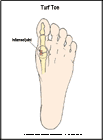
Turf Toe
What is turf toe?
Turf toe is pain at the joint where the big toe attaches to the rest of the foot.
How does it occur?
Turf toe can result from excessive pushing off of the big toe when you run or jump. Jamming the toe into a hard surface can also cause turf toe.
What are the symptoms?
You have pain where your big toe attaches to your foot. You may have difficulty bending and straightening your toe. Your toe joint may be swollen.
How is it diagnosed?
Your health care provider will ask about your symptoms and examine your toe. He or she may order an x-ray to be sure you did not break your toe.
Turf toe can sometimes look like gout, a type of arthritis of the big toe. Your provider may order tests to be sure you do not have gout.
How is it treated?
Treatment may include the following:
- putting ice packs on your toe for 20 to 30 minutes every 3 to 4 hours for the first 2 to 3 days or until the pain goes away
- elevating your foot on a pillow
- taking anti-inflammatory medications prescribed by your health care provider.
One of the keys to treating turf toe is keeping the toe from moving too much. Your toe can be taped to restrict how much it moves. You may have a special insole placed in your shoe that will reduce the movement of your big toe.
When can I return to my sport or activity?
The goal of rehabilitation is to return you to your sport or activity as soon as is safely possible. If you return too soon you may worsen your injury, which could lead to permanent damage. Everyone recovers from injury at a different rate. Return to your sport or activity will be determined by how soon your toe recovers, not by how many days or weeks it has been since your injury occurred. In general, the longer you have symptoms before you start treatment, the longer it will take to get better.
You may safely return to your sport or activity when, starting from the top of the list and progressing to the end, each of the following is true:
- You have full range of motion in the injured toe compared to the uninjured toes.
- You have full strength of the injured toe compared to the uninjured toes.
- You can jog straight ahead without pain or limping.
- You can sprint straight ahead without pain or limping.
- You can do 45-degree cuts, first at half-speed, then at full-speed.
- You can do 20-yard figures-of-eight, first at half-speed, then at full-speed.
- You can do 90-degree cuts, first at half-speed, then at full-speed.
- You can do 10-yard figures-of-eight, first at half-speed, then at full-speed.
- You can jump on both feet without pain and you can jump on the foot with the injured toe without pain.
How can I prevent turf toe?
Turf toe is best prevented by wearing good shoes that fit properly and by avoiding jamming your big toe into a hard surface.

